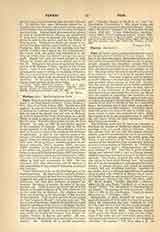

Faye, HERVE-AUGUSTE-ETIENNE-ALBANS, astronomer, b. at Saint-Benoit-du-Sault (Indre, France), October 1, 1814; d. at Paris, July 4, 1902. The son of a civil engineer, he entered the Ecole Polytechnique in 1832 to prepare for a similar career. He left the school before the end of the second year and went to Holland. In 1836 he entered the Paris Observatory as a pupil. There, in 1843, he discovered the periodic comet bearing his name. This discovery gained for him the Prix Lalande. As early as 1847 he was elected member of the Academy of Sciences. From 1848 to 1854 he taught geodesy at the Ecole Polytechnique and then went to Nancy as rector of the academy and professor of astronomy. In 1873 he was called to succeed Delaunay in the chair of astronomy at the Ecole Polytechnique, where he worked and lectured until 1893. He held other official positions: inspector-general of secondary education (1857); member (1862) and later (1876) president of the Bureau des Longitudes; for a few weeks only, minister of public instruction, then inspector-general of higher education (1877); and member of the superior council of public instruction (1892). Chevalier of the Legion of Honor in 1843, he became officer in 1855 and commander in 1870. He was honored with other decorations and by election to the membership of the principal European academies and societies. Faye’s fame rests both on his practical and on his theoretical work. He improved the methods of astronomical measurement, invented the zenithal collimator, suggested and applied photography and electricity to astronomy; and dealt with problems of physical astronomy, the shape of comets, the spots of the sun, meteors, etc. Credit is given by him as well as by his friends to the great influence of his wife, whom he met on his early trip to Holland. His religious nature finds corroboration in his knowledge of the wonders of the universe. Coeli enarrant gloriam Dei, he quotes in “Sur l’origine du Monde”, and goes on to say: “We run no risk of deceiving ourselves in considering it [the Superior Intelligence] the author of all things, in referring to it those splendors of the heavens which aroused our thoughts; and finally we are ready to understand and accept the traditional formula: God, Father Almighty, Creator of heaven and earth”. He contributed over 400 memoires and notes to the “Comptes rendus”, the “Bulletin de la societe astronomique”, “Monthly Notices of the R. A. S.”, and “Astronomische Nachrichten”. His larger works are: “Cours d’astronomie de l’ecole polytechnique” (Paris, 1883); Humbolt’s “Cosmos”, tr. by Faye and Galusky (Paris, 1849-59); “Cours d’astronomie nautique” (Paris, 1880); “Sur l’origine du monde” (Paris, 1885).
WILLIAM FOX

